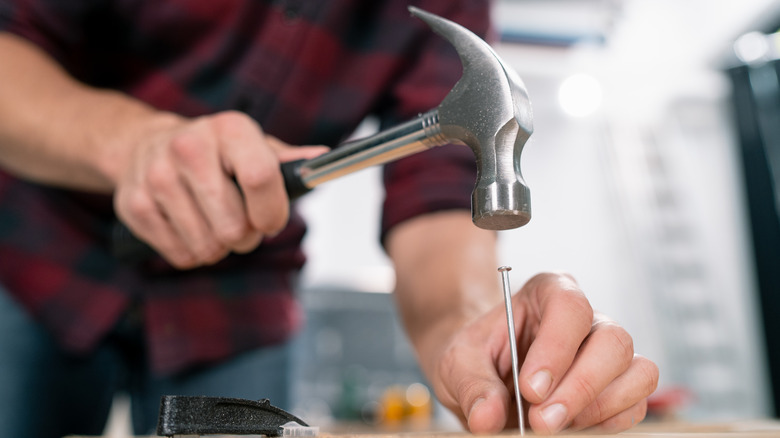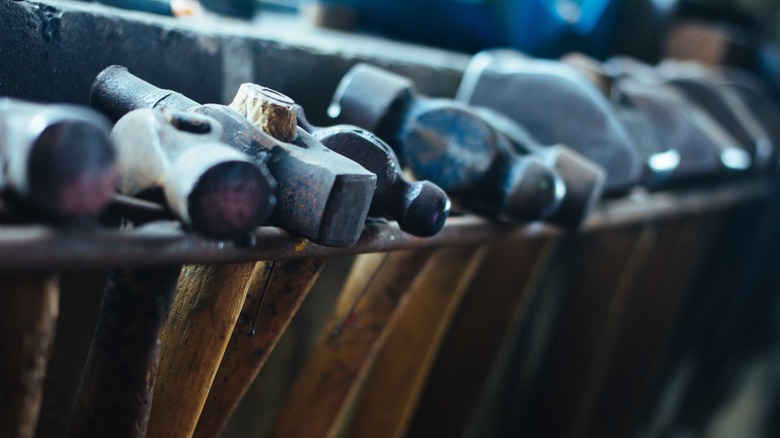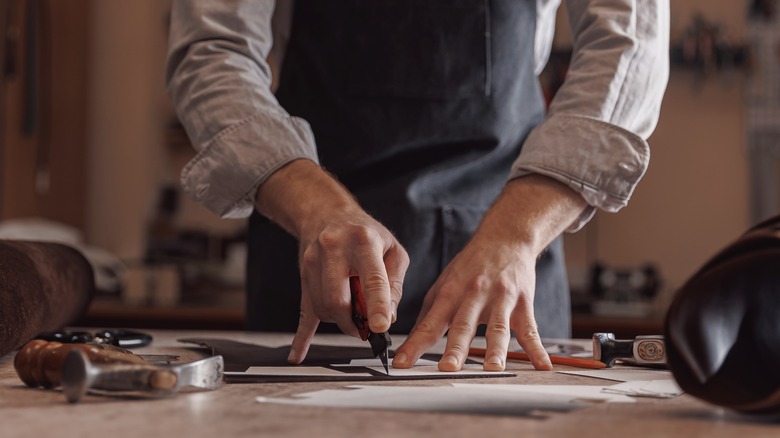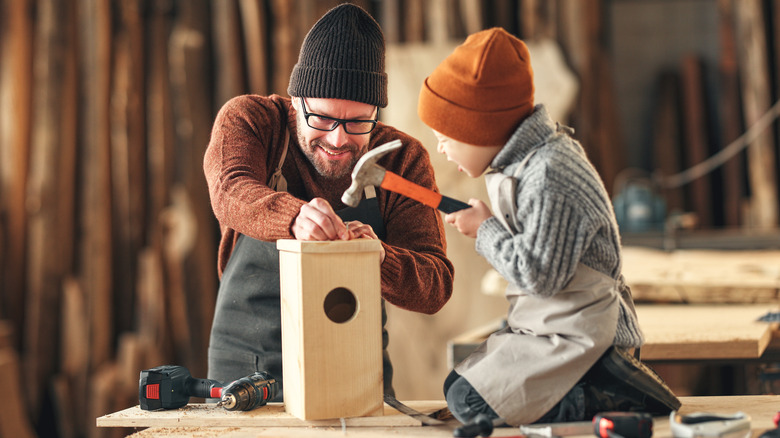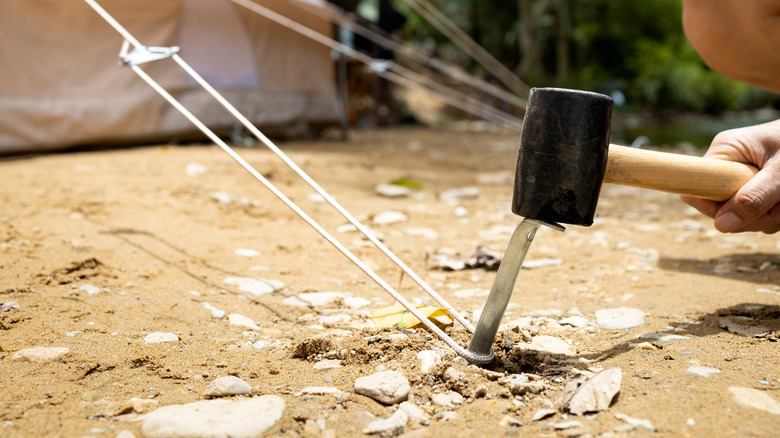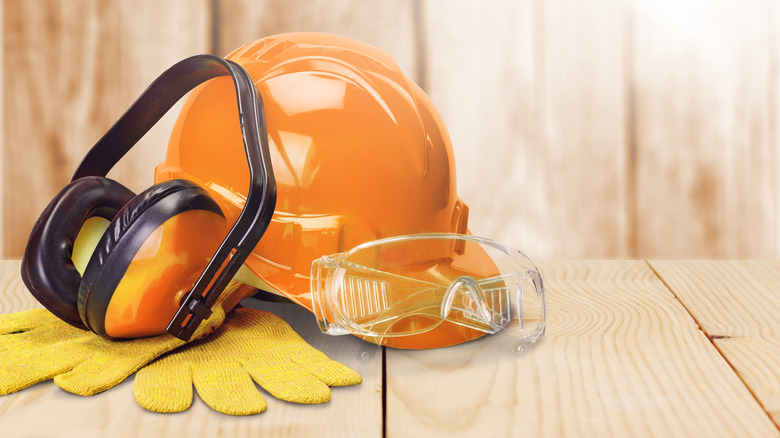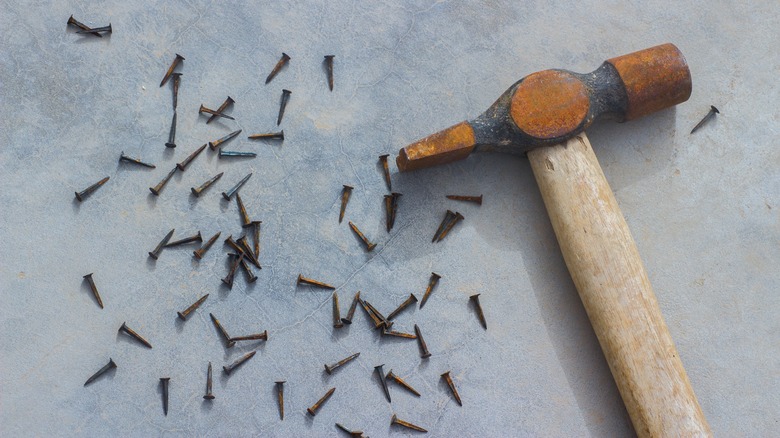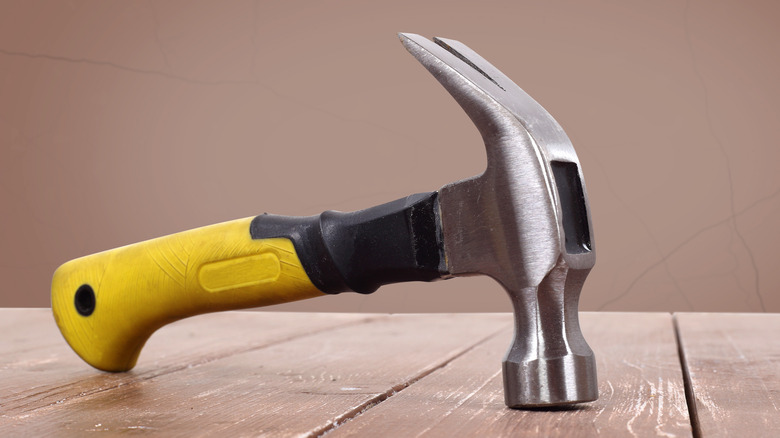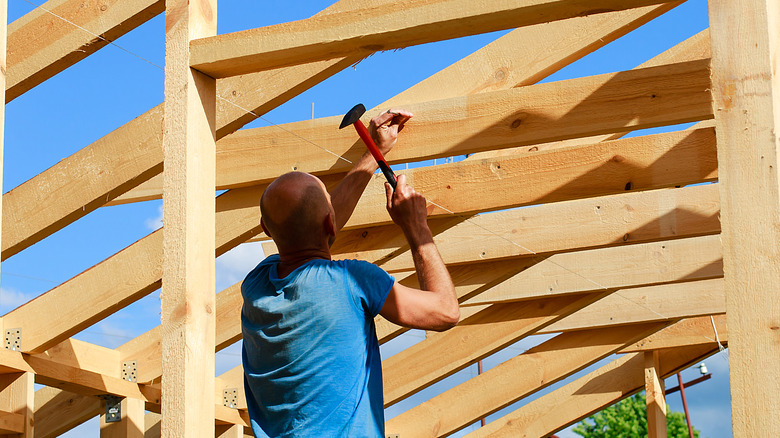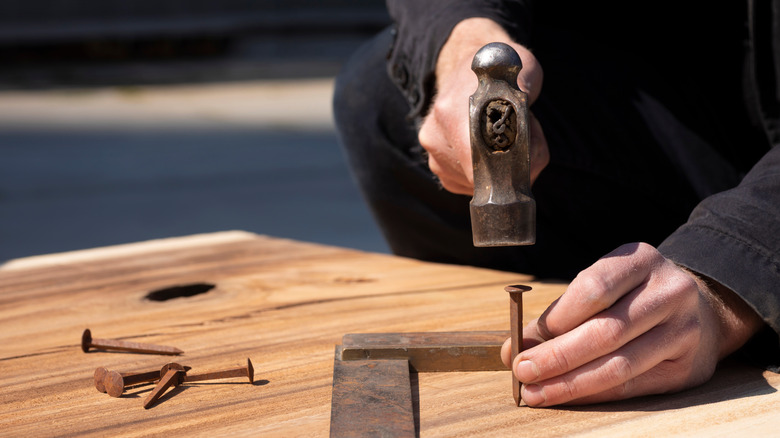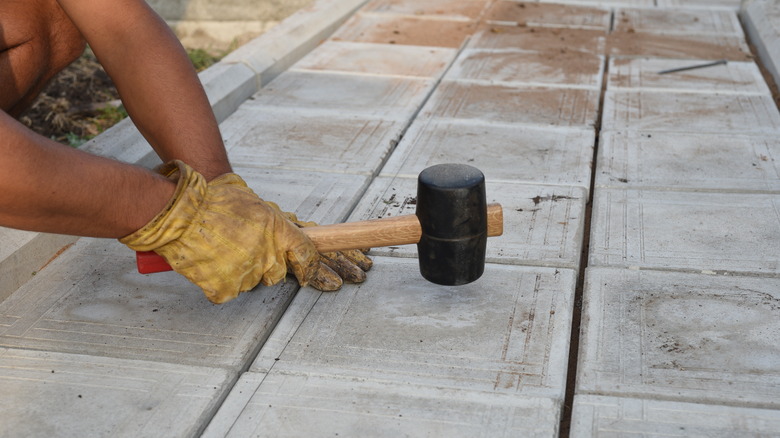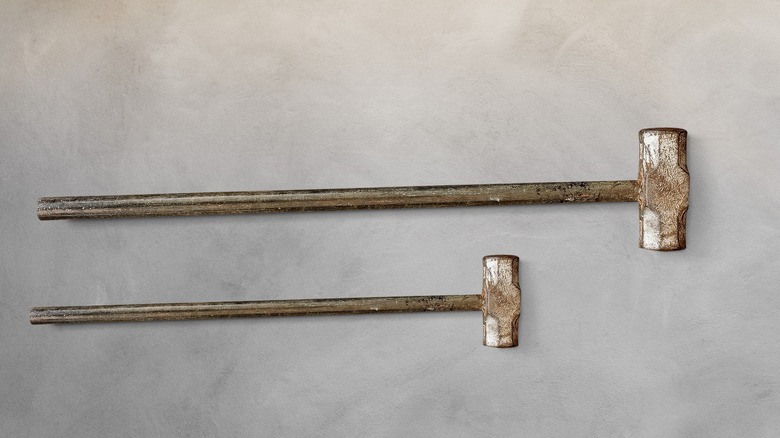What To Know Before You Buy A Hammer
Hammers are one of humankind's oldest tools, and the earliest designs were nothing more than rocks bound to sticks. Over centuries of development, hammers have been innovated to be more powerful, easier to wield, and more specialized for specific uses. Unskilled and professional workers require this equipment for general carpentry, framing, nail pulling, and driving. It's also required for building and assembling furniture, upholstering, finishing, riveting, and shaping metal.
Due to the wide array of uses, different types of hammers come in various shapes and sizes to make them more practical for certain tasks. Whether shopping online or at a local hardware store, you'll likely find dozens of hammers from several brands for sale, including standard claws, framing, mallets, sledgehammers, and more. Determining what kind of hammer best suits your planned tasks requires a deeper understanding of this simple tool, so you can trust yourself to choose a reliable design from a reputable brand. Keep reading to learn everything you need to know about hammers!
What are the parts of a hammer?
Knowing the parts of the hammer helps to differentiate the type, making it easier to discern which one you need. Many hammer part names are inspired by human anatomy and labeled as the face, neck, eye, cheek, claw/back, handle, and grip. The head of a hammer includes the face, neck, eye, cheek, and back part. Most people are familiar with the "face" section, which is the side of the head that makes direct contact with objects when this tool is swung. The cheeks and neck make up the center of the head, while the back end has different names depending on its shape.
The back of the hammer has alternative names because its functionality depends on the hammer type; the shape may be optimized for molding, forging, tightening, or loosening your craft. Meanwhile, the handle and grip serve their own unique purpose, as they are solely designed to make handling the hammer easier and safer. The length of the handle keeps your working hand out of danger, while the grip helps you maintain a steady hold on the tool as you utilize its head.
What size hammer do you need?
Hammers come in various sizes, as they are optimized for different people and purposes. You can find standard styles for common tasks that only weigh half a pound, while heavy-duty options for grander ventures can weigh over 10 pounds. Several factors should influence the size you choose for yourself.
Think about the scale of your intended project, how often you'll need this tool, and, most importantly, the limits of your own strength. A smaller hammer is probably a better option if you're hammering on compact sections or precise locations. In contrast, a heavier hammer will be a more rational and efficient choice if you're embarking on a large-scale project such as demolition. Remember that a hammer is only as powerful as you can swing it. If you don't have the body strength to repeatedly swing a weighty hammer, it won't do you much good for any intention.
What type of handle is best suited for your needs?
In addition to the different styles and weights, many hammers sport different handles and grips. Most hammer handles are made of wood, fiberglass, or metal, and the "best" choice is up to personal preference. Wooden handles are the traditional option and are known for being lightweight, making it easier to apply power to the hammer head when swinging them. This makes them a preferred choice, especially for casual DIY-ers and people with weaker arm strength. However, wooden handles are less sturdy than metal or fiberglass and are vulnerable to humidity and rain damage if left outside.
Metal handles are another option to consider, and they are usually outfitted with a rubber or cloth grip that gives users a better handhold since they are smooth and heavy to bear. This material is least likely to break while hammering, making it the most durable choice. However, it is also naturally the heaviest since the entire tool is made of metal, not just the head portion. Fiberglass is the happy medium between wood and metal. It's lighter than metal, stronger than wood, and not vulnerable to rot or warping due to moisture exposure. These handles are also outfitted with rubber or cloth grips to make handling easier since they have the same smooth texture as metallic options.
What precautions to know about hammer use
Since hammers are so widely used, they are also one of the most misused tools by casuals and professionals alike. There are so many different sizes and types for a reason — so people can use the correct tool for the job at hand. To ensure a project's safety and success, you should be aware of manufacturer recommendations for hammer use.
Your chosen hammer should have a face diameter of at least half an inch larger than the item you are working on to ensure you get full coverage when striking it. The tool should also be properly balanced to ensure weight is distributed throughout its operation. If a project involves electrical equipment, make sure the handle is properly insulated to avoid dangerous accidents, and as a final note, defective hammers should be disposed of promptly. Loose heads and handles won't withstand the pounding actions associated with hammer work and greatly increase a working person's chance of injury.
What safety gear is necessary?
No one wants to be the poster child for a DIY carpentry project gone wrong. When searching for the perfect hammer, don't be afraid to invest in personal protective equipment (PPE) to make your purchase safer. As with most home projects, protective eyewear is always highly recommended. A pair of safety goggles or glasses can protect your eyes from flying debris that results from hammering activities. Small pieces can shatter or splinter as you strike and shape metal and woodwork, turning them into tiny dangerous projectiles. Your project could take an unfortunate turn if you don't have a barrier between your eyes and those projectiles.
Aside from eyewear, you should also consider protecting your hands. One of the most common ways people get injured while hammering is by accidentally hitting their own fingers. Wearing thick gloves won't give your hands complete immunity to an accidental hammer bash, but it does mitigate the resulting injury. The extra padding can save your fingernails, prevent bones from being broken, and lessen the pain of the impact. If you're using other power tools and equipment alongside hammering, you may want to invest in additional PPE, such as a protective helmet, respirator, and ear protection.
What to avoid when purchasing a used hammer
It isn't always necessary to buy a brand-new hammer online or at a local shop— plenty of people are willing to part with tools they no longer need. However, while you're browsing used options, you should keep an eye out for certain defects before committing to a purchase. Make sure the head isn't loosely attached, the handle is comfortable in your hand, and the head hasn't been redressed, ground, welded, or changed in any way from its original shape.
A manipulated tool no longer meets manufacturer safety regulations, meaning it could be dangerous for short- or long-term use. You should also watch for chips on the face, cracks on the prongs in clawed designs, and any dents throughout its structure. Remember that you get what you pay for, and if a person offers a hammer for an absurdly low price, there may be a reason behind it.
What are the top hammer brands?
Based on best-selling results from top hardware and home improvement stores, brands like Estwing, Stanley, and Irwin manufacture some of the top-rated hammers available for purchase. Estwing hammers are revered for their innovative shock-absorbing grips and long-term durability. This brand sells claw hammers, framing hammers, and mallets, and their AL-PRO line is forged from aircraft aluminum, making it lightweight and useful for small and large tasks. They are also outfitted with magnetic nail starters, which hold nails in place so you don't have to do it by hand.
The brand Stanley sells a larger assortment of hammers, which are high value and low cost like Estwing products. They have over 70 hammer designs, ensuring you'll find something that fits your DIY and home improvement needs. Meanwhile, Irwin is a smaller hammer manufacturer solely selling curved claw tools. Although their product line is minimal, their selection of tools is guaranteed to be premier quality. Each hammer has an ergonomic handle, features to prevent slippage, and satisfactory customer reviews.
What to know about claw hammers
Claw hammers are the "standard" hammer style and are the most common design on the market. You can identify this type by the claw-like shape of the head, where the metal is molded with a center slot cut out. This makes them primarily helpful in driving and extracting nails while putting together furniture, hanging up home decor, and executing other minor household tasks.
Claw hammers are further divided into two subcategories: rip claw and curved claw. Rip claws have a rectangular, straight shape and are useful for heavy-duty work. In comparison, curved claws are better for typical home projects and finishing work. Both of these hammers tend to weigh between one to two pounds, though rip-claws are slightly heavier since they are often used for larger projects. You can find both claw forms at local home improvement stores for less than $10s, but cheaper instruments may not last long-term. Pricier claw hammers are usually made with more durable materials or protective finishes, making them less vulnerable to wear and tear.
What to know about framing hammers
Large-scale carpentry projects require slightly more specialized hammers than the standard rip or curved claws. When re-framing walls or constructing joists, trusses, rafters, or other major woodworking projects, a framing hammer is the best option. Framing hammers have the same pronged head as claw types but differ in that they have longer handles, weigh between 22 and 32 ounces, and their opposite face has a milled surface.
The milled surface helps you keep your place while hammering, keeping you from slipping off the nail head. After using a milled surface, you often need to do additional finishing work to cover up the uneven texture that results from it. If you take a look at most home improvement stores, you can find framing hammers for around $30 to $100, though the price can be higher or lower depending on the quality you're willing to settle for.
What to know about ball peen hammers
A ball peen hammer is the claw hammer's front-running rival, making it another of the most popular types on the market. This hammer has a ball instead of a claw opposite of the face, and this component is often referred to as a "peen" or "pain." The ball peen hammer is designed for metalworking projects; the flat side is for pounding metal into place, while the peen is used to roll over and shape it.
These hammers come in various sizes, from four to 32 ounces, and you can usually find them priced between $20 to $50. Since these tools are built for striking metal, it's recommended that you purchase a style that is made entirely of a single material. You want the entire hammer constructed of steel or another sturdy metal to reduce the likelihood of the head snapping and breaking on impact.
What to know about mallets
Following the style of a cleverly designed ball peen hammer, a mallet is usually made entirely of a single material: solid wood. If there is another material used to create this style, it's rubber for the head. These hammers are used to assemble pieces that a standard-style hammer would break, having a weaker strike since the heads are made of softer materials. They are ideal for hammering on surfaces where you don't want to leave track marks and are often used for fitting wooden pieces and working with plasterboard.
"Dead blow" hammers are heavy-duty versions of mallets; they have the same expanded head shape but are made of metal to deliver a powerful wallop. A layer of polyurethane is coated over the head to minimize disfigurements in the metal project being worked on. Rubber and wooden mallets run from $10 to $50 on average, while dead blow hammers can cost hundreds.
What to know about sledgehammers
If you're looking for the largest, most powerful hammer you can buy, you should go with a sledgehammer. These two-handed tools are designed to clobber surfaces with maximum blunt force and are used to drive stakes, straighten constructive works, dislodge items, and even demolish walls. You should be able to discern three main types before choosing the sledgehammer you need: engineer, post-maul, and standard.
An engineer's sledgehammer is wieldable with one or two hands and is useful for forcing chisels into woodwork, while post-maul designs have wide-sized heads ideal for driving stakes and fence posts into the ground. Standard sledgehammers can do both of these tasks, though they aren't specially designed to perform them as well as the two aforementioned types. They are better for general hammer work and are recommended if you have a variety of home improvement projects lined up. The larger the hammer, the higher the price, although most range from $30 to $100 or more.
